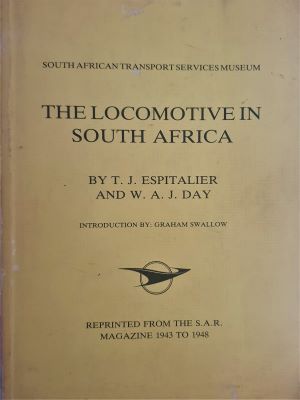The Locomotive in South Africa: Reprinted from the SAR Magazine 1943 to 1948
The steam locomotive of South Africa has always held a fascination for many people, but, strangely, very little had been written about them before the last war, with the exception of the typical technical journalistic material in magazines such as Engineering, The Engineer, Railway Gazette and of course, our own South African Railways magazine. The demand for a definitive treatment of this alluring subject became apparent. Early in 1943 Theo J. Espitalier, a draughtsman in the offices of the Chief Mechanical Engineer (C.M.E.) was advised by Dr. M. M. Loubser (C.M.E.) that Mr. C. M. Hoffe (General Manager, SAR) wanted him to compile a history of the locomotive in South Africa. Espitalier was at the time, involved with the recovery of “Natal” (the locomotive which hauled the first public train in South Africa in 1860). Espitalier then began his research on the history of locomotives in South Africa, of which he already had a vast knowledge and in June 1943 the first in a series of articles was published in the South African Railways magazine. W. A. J. Day, who in 1940 retired from the position of Assistant General Manager (Technical), co-authored this remarkable series. The series included the periods of the 4ft 8in gauge, the Cape Government Railways, the Natal Government Railways, the N.Z.A.S.M., the Imperial Military Railways, the Central South African Railways and the South African Railways up to 1948.
*Cover handling marks; corners curling; store stamp on first page*
| Author | T. J. Espitalier & W. A. J. Day |
|---|---|
| Publisher | South African Transport Services Museum |
| Place | South Africa |
| Year | 1989 |
| Binding | Paperback |
| Condition | Good |
| Comments | Cover handling marks; corners curling; store stamp on first page |
How we describe the condition of our books
We are very proud of the condition of the books we sell (please read our testimonials to find out more!)
New: Exactly as it says.
As New: Pretty much new but shows small signs of having been read; inside it will be clean without any inscriptions or stamps; might contain a remainder mark.
Very Good: Might have some creases on the spine; no hard cracks; maybe slight forward lean and short inscription inside; perhaps very minor bumping on the corners of the book; inside clean but the page edges might be slightly yellowed.
Good: A few creases on the spine, perhaps a forward lean, bumping on corners or shelfwear; maybe an inscription inside or some shelfwear or a small tear or two on the dustjacket; inside clean but page edges might be somewhat yellowed.
Fair: In overall good condition, might have a severe forward lean to the spine, an inscription, bumping to corners; one or two folds on the covers and yellowed pages; in exceptional cases these books might contain some library stamps and stickers or have neat sticky tape which was used to fix a short, closed tear.
Poor: We rarely sell poor condition books, unless the books are in demand and difficult to find in a better condition. Poor condition books are still perfect for a good read, all pages will be intact and none threatening to fall out; most probably a reading copy only.


